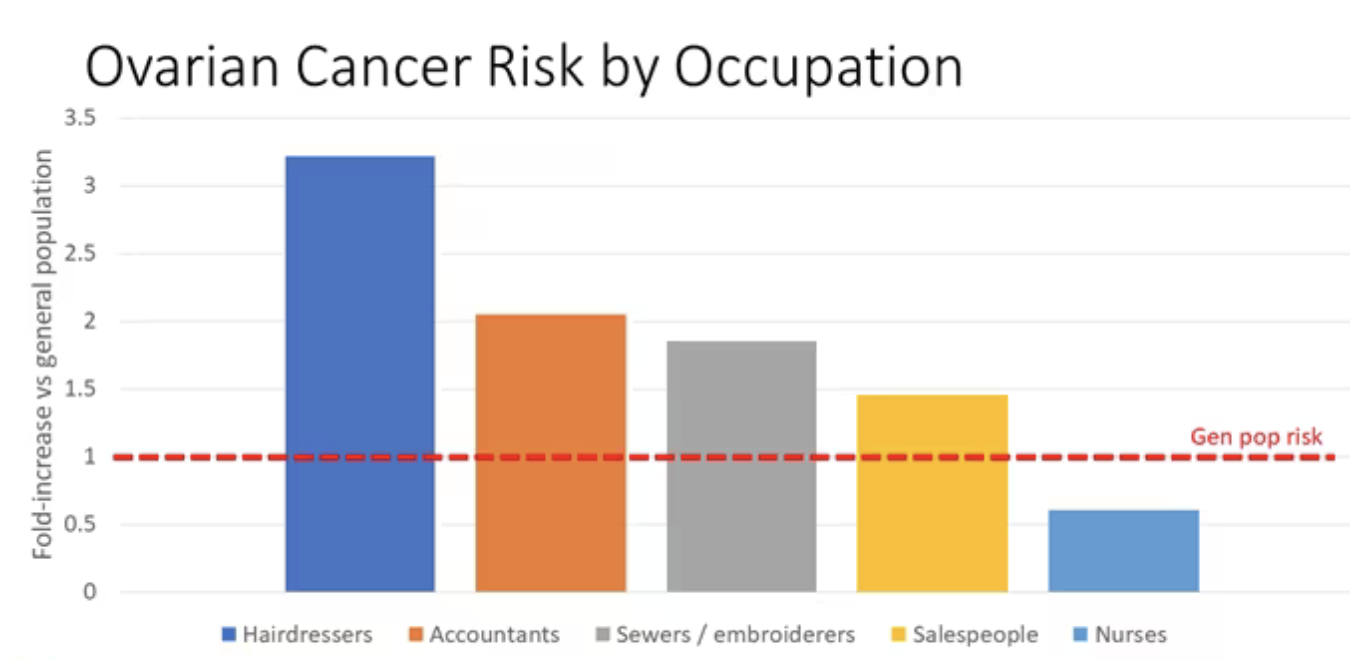New cancer research reveals unknown facts about hairdressing and accounting!
As someone who works in cutaneous oncology i.e., skin cancer, and has an interest in genomics and how our lifestyles affect our genes (my book, The Genetics of Health, is now translated into German, Italian and several other languages) we know that cancer risk is determined by both nature (genes) and nurture (lifestyle).
The topic of this blog may be a bit macabre, but I was using a scientific lens to look behind the scenes of professions. I was looking at death rates of doctors, hairdressers and accountants and found some facts that have been overlooked that reveal more about some jobs that we should perhaps consider, and act on.
My own profession of medicine ranks high for suicide rates. Dentistry was long considered No 1, and one can perhaps rationalise it by thinking that no one loves going to their dentist, but it turns out that statistic—even quoted to this day by many dentists to me—is a myth. Apparently, a series of media articles in the 1960s had suggested that dentists had a suicide rate of 2.5 to 5.5 times higher than other white-collar workers. The American Association of Dentistry naturally became concerned, and looked into this and a study completed in 1975 concluded that “data from 31 states failed to support the conclusion that dentists committed suicide at higher rates than the general population.”
Medicine, with long hours of brutal training is one in which you can rarely turn off completely until retirement and is considered stressful. A recent study from Australia showed that among men in healthcare (including dentistry and veterinary) only veterinarians had a significantly increased suicide risk compared to the general male population. Having to euthanise family pets cannot be good for animal lovers’ mental health. Among females, the suicide risk was significantly elevated for female veterinarians as well as female physicians and pharmacists.
In scientific research, there are many kinds of studies—meta-analyses combine the statistics from many trials and look for patterns that are often missed in single trials; randomised controlled trials against placebo are the gold standard for drug development. But when one is trying to look for hidden patterns, case control trials can be useful as the discussion below will explain.
Cancers can be frightening because they affect an infinite number of people and can strike randomly. The immune system, our body’s army, often struggles to win the battle because replication is a tumour’s schtick. Cancers can be beaten, but not before they destroy a bit of our bodies. Those that survive have an oral history we can study and understand.
I was looking at ovarian cancer mostly because –with a degree in law and ethics—I am often asked to review cases that are before tribunals and provide an expert opinion. Here I was dealing with a case of an ovarian cancer that had been missed by a doctor in another city and treatment had been delayed. That got me interested in ovarian cancer because I am a compulsive student and love researching and finding new information. Every such journey becomes a trap from a personal time point of view, or a trapdoor into the self and the shadow of a malady.
We know that females with BRCA gene mutations have a higher risk of breast and ovarian cancer. We cannot change our genetic blueprint. Other things like when a female first gets her period or first has children also modifies ovarian and breast cancer risk, but these are things mostly beyond a woman’s control. This is where case control studies are useful like the one published in the BMJ Occupational and Environmental Medicine.
The study was done in Montreal, Canada. Lifetime occupational histories were collected for 491 cases of ovarian cancer and 897 controls i.e., similar women, matched for age, socioeconomics etc. The team looked at every job a female had worked at, and the duration. Each occupation was mapped to a standardised set of industries, and the exposure to chemicals or toxins within each industry. For example, radiologists had exposure to heavy metals, textile workers to dusts and fibres, painters to solvents etc. But in this study looking at ovarian cancer, two occupations stood out: hairdressers (more than 3 times as likely to develop ovarian cancer) and accountants (more than twice as likely). Hairdressers, who had been in the industry for more than 10 years, had a threefold higher risk for ovarian cancer when compared to women who had not worked in the occupation!

The research did not look at causes, but we know that hairdressers are exposed to aromatic hydrocarbons, bleaches, ethanol, and fluorocarbons, and these may be the culprits. If you are working at a hairdresser, my advice would be to have well ventilated places with airflow to the outside. But almost every hairdresser I have visited works indoors in a closed environment with no natural air. Food for thought.
Accountants having twice the ovarian cancer risk is interesting. Of course, it could be a false positive as the rate is not as high as hairdressers, but significant enough to be noted. But this job involves sitting at desks surrounded by office printers. Who knows, there may be exposure to volatile organic compounds from office printers. Again, most accounting firms are closed offices, with no outside ventilation.
Case control studies are not designed to look at causes but offer an insight for others to carry on the work. We know that ovarian cancer is slightly more common than cervical cancer (that gets more publicity) among women, and usually develops after menopause. Both breast and ovarian cancer are both linked to the BRCA gene mutations in some women. However, the same increased risk has not been noted for breast cancer among hairdressers. Interesting.
I have many patients who are hairdressers and accountants and people may find this blog frightening. Being forewarned is forearmed. My message is, if you are in these higher-risk occupations, remember to get regular health checks (especially after you stop having periods), and try to improve the ventilation in your workspaces. In following the science, it led me to places that are often not considered as risky—and may have revealed more about the modern times we live in.
THE END
IMPORTANT: This blog is about science-communication, education, interesting science, and new medical research to do with (mostly) health and skin. It is not individual one-on-one medical advice.
Written By
Dr Sharad Paul
Dr Sharad Paul is an award winning, world renowned recognised skin-cancer expert and thought-leader.






